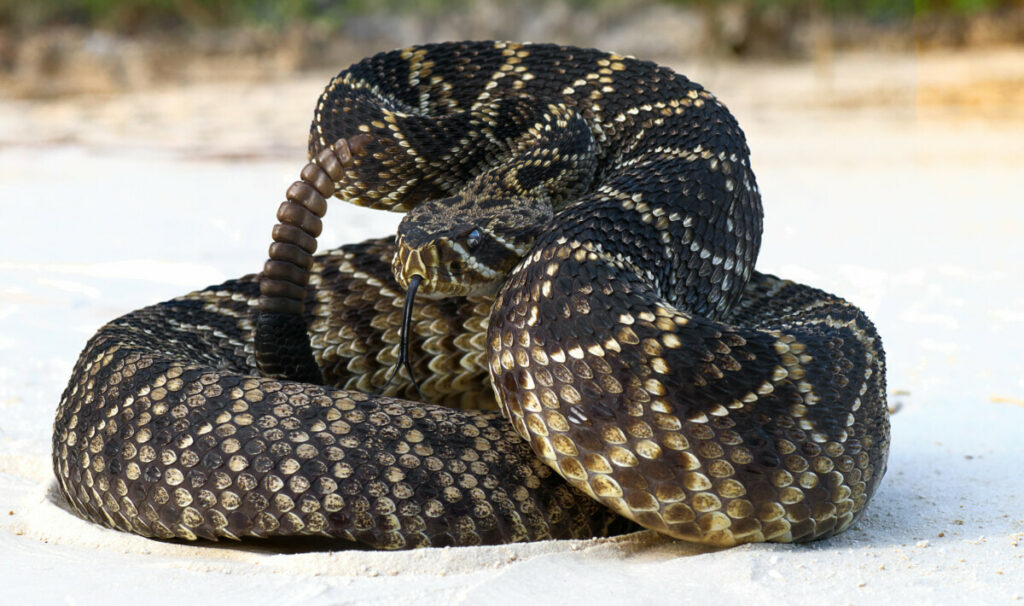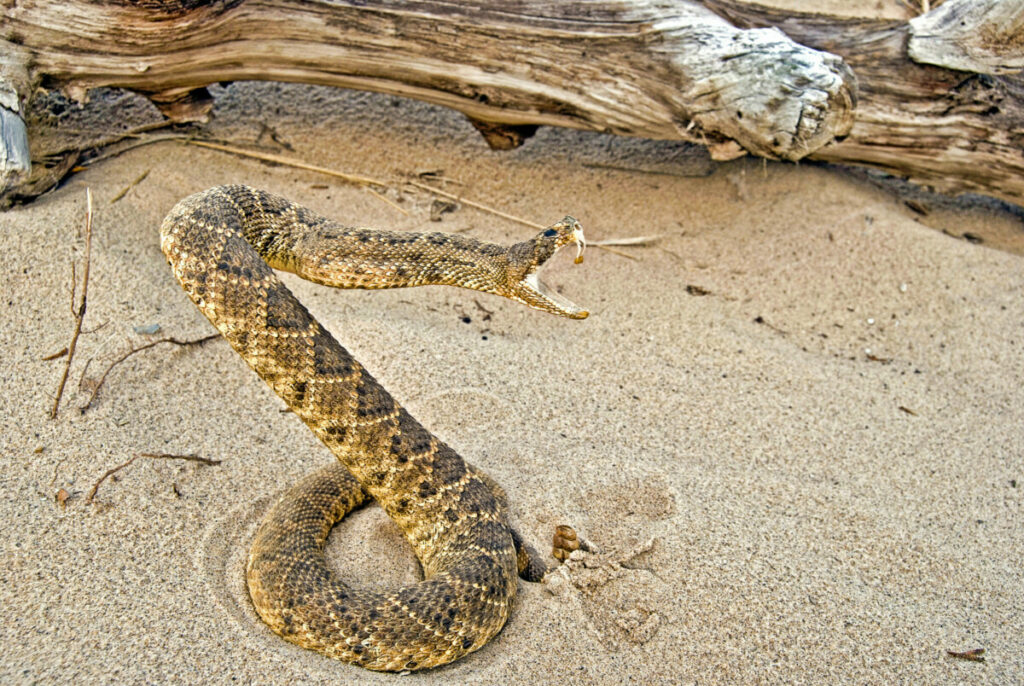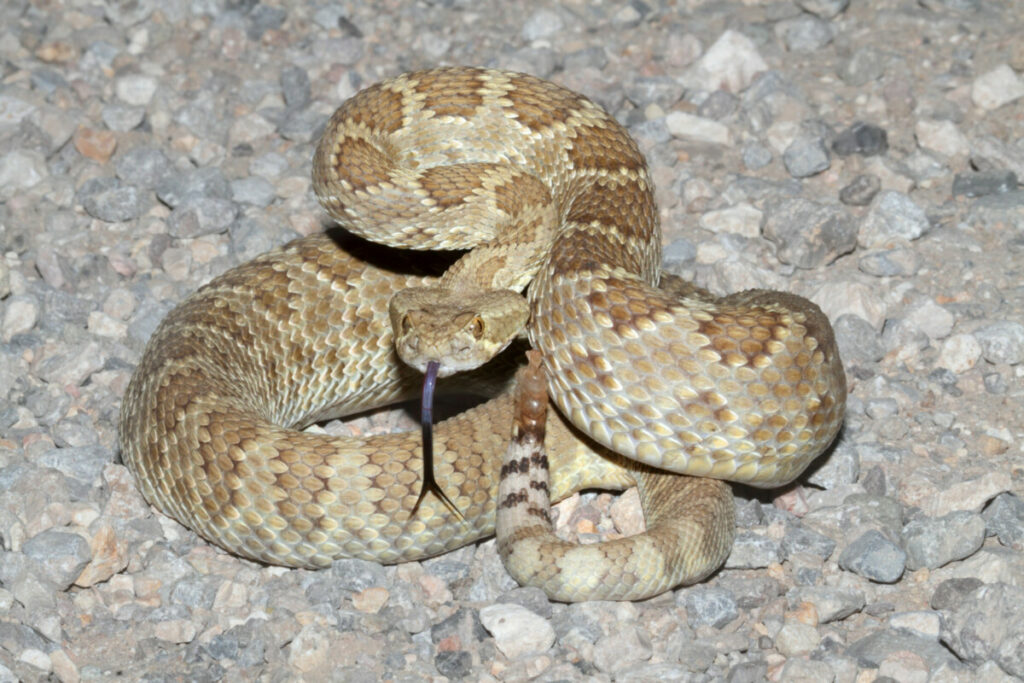
Being primarily desert-dwelling creatures, rattlesnakes seem to have very little to eat. Here is a quick guide on rattlesnake diets and hunting habits.
Rattlesnakes primarily eat small mammals. However, with 30 currently recognizable species living in a wide range of habitats, it is not uncommon for a rattlesnake to eat ground-dwelling birds, insects, and small reptiles. Adults rattlesnakes only need to feed about once every two weeks.
Here is a short guide on rattlesnake diets, regardless of habitat, rattlesnake venom, what hunts rattlesnakes, and how to identify them.
A Basic Rattlesnake Diet
For the most part, rattlesnakes eat small mammals. They swallow their prey whole so what they can eat is really determined by what they can fit in their mouths and stomach. Anything from rabbits to ground squirrels to mice is free game for a rattlesnake.
However, rattlesnakes are very adaptable and can live pretty much anywhere from deserts to meadows to swamp lands. Pretty much anything between sea level and around 11,000-foot altitude could be a rattlesnake home. That means different species can have different food sources and therefore have slightly different diets.
What Do Adult Rattlesnakes Eat?
Rattlesnakes can eat pretty much anything they can swallow. This is especially true for adult rattlesnakes. Some rattlesnakes can reach 7+ feet in length, making their mouths big enough for rabbits, ground squirrels, and ground-dwelling birds.
They are not against eating other reptiles, as long as they can swallow them whole, and will eat insects if they have to. Rattlesnakes love to eat small mammals, specifically rats, mice, rabbits, and ground squirrels.
Rattlesnakes eat by consuming their prey whole after it has been stunned by the venom in the rattlesnake’s fangs. Once they have eaten a meal, adult rattlesnakes can go 2 weeks, or even longer depending on the size of their last meal, before needing to eat again. During the digestion process, rattlesnakes are lazy and sluggish, staying close to the shaded and covered areas of their habitat.
What Do Young Rattlesnakes Eat?
To some people’s surprise, not all reptiles lay eggs. Rattlesnakes are ovoviviparous, which means baby rattlesnakes are born not in an egg. The mother rattlesnakes keep the eggs inside of her for about 90 days before giving birth to baby rattlesnakes in a clear, thin membrane.
The baby rattlesnake then must poke its head out and take its first breath of air. Because baby rattlesnakes are born rearing to go, they hunt for food pretty soon after taking their first breath of fresh air.
Baby rattlesnakes do not leave the birth site until they have shed their first skin, which happens about one week after they are born. Once they leave the nest, they tend to eat smaller things like lizards and amphibians.
While one of the main benefits of eating small lizards and amphibians is that they fit inside the baby rattlesnake’s mouth, these prey animals are also more susceptible to the rattlesnake venom and are therefore easier to kill and consume. (Source)
As they grow, their food options become wider and they have more time to spend between meals lounging around in the sun. On average, a baby rattlesnake needs to eat about once a week, depending on the size of the meal.
How Rattlesnakes Hunt

Rattlesnakes are pit vipers. That means they have little pits under their nostrils that allow them to see the heat of warm-blooded prey and other warm-blooded creatures. Because of this, they are perfect ambush predators.
Rattlesnakes only hunt when they are hungry. Rattlesnakes will slither to a spot that has good coverage and camouflage and then they will wait for a mouse or rabbit or one of their possible food sources to come to them.
Once something crosses their path that they can eat within striking range, which is about two-thirds of their body length, they bite the animal.
A rattlesnake can strike at about five-tenths of a second. A human blink takes about one-tenth of a second. That means that two blinks are about the time it takes for a rattlesnake to strike and bite its prey.
Rattlesnakes Kill Their Prey With Venom
Once their prey has been bitten, a rattlesnake will back off and wait for its prey to die. A rattlesnake will track its prey using its forked tongue and heat sense.
The rattlesnake’s forked tongue leaves its mouth to taste the air, collecting scent particles that will help the snake identify what it is smelling, before running its tongue along the roof of its mouth to give those collected particles to the vomeronasal organ, or Jacobson’s organ.
This organ helps the rattlesnake identify what it has “smelled” and thus track or run and hide from whatever it has come into contact with.
Once the rattlesnake’s prey is either dead or stunned long enough to be consumed, the rattlesnake opens its jaws and consumes its prey whole. Rattlesnakes, and snakes in general, can open their mouths at about a 150-degree angle.
Once the prey is safely in the rattlesnake’s belly, the rattlesnake takes the next two weeks or so to digest and relax.
Rattlesnake Venom
Rattlesnake venom has two primary functions. One, stunning and taking down prey. Two, kickstarting the digestive process. In other words, rattlesnake venom begins to digest its prey and thus aids in killing it for consumption.
As a general overview, snake venom can be categorized into two groups: high molecular mass (HMM) enzymes and low molecular mass (LMM) neurotoxins. both of these venoms rip through the blood and soft tissues causing swelling, pain, and necrosis. Rattlesnake venom is typically somewhere between the two and is known as PLA2.
The potency of the venom in rattlesnakes depends on and changes two main things: habitat and species. Though it is important to note that potency can and does vary within specific species.
Venom is injected into the prey as soon as the rattlesnake strikes and bites it. The venom comes from glands in the upper jaw and slides through the venom duct before leaking into the prey’s bloodstream via the hollow fangs.
Rattlesnakes can control the amount of venom produced and injected into their prey. Bigger prey requires more venom.
Baby Rattlesnake Venom
It is a myth and common misconception that a baby rattlesnake’s venom is more potent than an adult’s. A baby rattlesnake cannot produce as much venom as an adult and does not have as much control, making it just as dangerous, if not a bit more so.
Despite rattlesnake venom being potentially deadly, it is being used for medicines and sciences. For example, the Brazilian rattlesnake’s venom has an analgesic–a drug used to ease pain– that is 30 times stronger than morphine, without the negative side effects of addiction.
Rattlesnake venom is also being used to help treat diseases like arthritis, thrombosis, cancer, and other such illnesses. (Source)
As a general rule, rattlesnakes tend to run away before attacking humans. However, if they are cornered, they can and will bite a human. Sometimes they give a warning before biting, other times they don’t.
If you have been bit by a rattlesnake, call 911. Especially if the bitten area is swelling, changing color, and/or is painful. It is important to remain calm, not to elevate the bitten area or limb above your heart, and stay as still as possible.
All of those things will help prevent the venom from reaching your heart faster which could kill you before a rescue team has the chance to get to you and save you.
What Hunts Rattlesnakes
Despite being an amazing hunting machine with a deadly bite, rattlesnakes do have preditors. Fox, eagles, roadrunners, hawks, coyotes, kingsnakes, and bobcats are all animals that view rattlesnakes as food. This causes the rattlesnake to avoid big open spaces.
Because it does have predators, that is just another reason why rattlesnakes are so good at camouflage. A rattlesnake’s pattern and color scheme of its scales blend in perfectly with its habitat making it hard to see and find.
However, not all of the rattlesnakes’ threats are animals that want to eat them. Animals like antelope, horses, deer, and cows see rattlesnakes as a threat and will try and stomp or trample them in order to kill and get rid of them. That is just another reason for the rattlesnake to keep away from open spaces and stay hidden.
Humans Are The Biggest Threat
The biggest hunters and threats to rattlesnakes are humans. Due to rapid habitat destruction in the name of putting up more buildings, deliberate extermination campaigns, and mass killing events like rattlesnake round-ups are pushing certain species of rattlesnakes closer to extinction.
In the case of the Arizona black rattlesnake, natural disasters such as drought and fires are more to blame. Sadly, that is not the case for most rattlesnakes.
With their habitats being destroyed and people being afraid of them and thus promoting mass killings of rattlesnakes for prizes based on weight and size, a rattlesnake’s biggest threat is a human. It has gotten so bad for some species that they have stopped rattling in order to warn threats of a strike.
This could become quite dangerous. The whole point of having a rattle is for rattlesnakes to warn threats to back off. If they are not rattling to warn us of potential threats, then humans could get bitten more often, which will cause more hospital visits and sadly, more rattlesnake-related deaths.
How to Identify a Rattlesnake

The biggest identifier of a rattlesnake is its rattle. The rattle is made up of keratin, the same protein that makes up your hair and fingernails. A new segment of the rattle is added to the tail every time the snake sheds. These segments can break off and are thus not a good way to guess a rattlesnake’s age.
A rattlesnake can move its rattle back and forth about sixty times a second. When rattled, it sounds like a sharp hissing.
The second best way to identify a rattlesnake is by its diamond-shaped head. Unlike other, non-venomous snakes, a rattlesnake’s head sticks out and is not the same width as its body. Because of its diamond, almost triangle shape instead of more of a rectangle, it has a bit more of a powerful bite and plenty of space for its fangs and venom sacks, things it needs to hunt and eat its prey.
Another great way to identify a rattlesnake is by its pits underneath its nostrils. Three of the most deadly venomous snakes in the United States have this same characteristic: rattlesnakes, cottonmouths, and copperheads.
The pit is there to give the rattlesnake heat-sensing vision that aids them in hunting their prey. These pits are so sensitive that the rattlesnake can identify the size of the warm-blooded creature it has sensed. These pits also allow the rattlesnake to see and hunt prey in complete darkness.
Rattlesnakes Blend Into Thier Environment To Hunt and Hide From Prey
Rattlesnakes come in a vast area of colors including tones of yellow, light pink, rust, olive, and cream to shades of blacks and greys to shades of browns. Rattlesnake skin can have three patterns ranging from diamond-shaped to blotched to banded.
Although, it is important to note that some species of rattlesnakes display no identifying scale patterns. Whatever the rattlesnake looks like, it is perfect for blending into its habitat allowing it to hide, relax, and hunt.
Rattlesnakes can live in most areas of the United States. So it is always a good idea to be on the lookout for them when outdoors. Rattlesnakes will not attack humans just to attack them. Like most animals, rattlesnakes only attack when threatened and as a last resort.
However, because they are so good at camouflaging themselves, they can sometimes be hard to spot. That is where their rattle comes in handy to warn threats of their presence. If you come across a rattlesnake, rattling or not, stay calm and move away at a casual, and calm pace.
If you are with other people, alert them to the rattlesnake’s location. Do your best to leave the rattlesnake alone and leave the area. All of these characteristics aid the rattlesnake in hunting, eating, and hiding from prey and predators alike.
